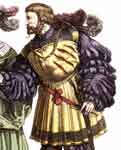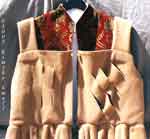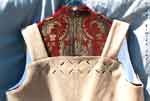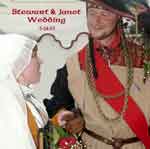 |
 |
 |
 |
 |
  |
 Stefan und Etta's Wedding Photo Album |
Introduction and Credits:
In the summer of 2002, my friend Cherylyn Crill came to me to create a German Military Captain's Waffenrock for her friend "Stefan" who wanted this created for his wedding that would be held during a renaissance faire. He is the leader of their German military guild, Das Heiligesturm Fähnlein1, and thankfully, his wedding would be in the spring of the following year.
I had never made a German outfit before, but I got to work on the Dopplesoldier's outfit before tackling this project. Cherylyn also helped me in the design of the garment, and taught me a lot about German fashion and construction. She provided me with a handout written by Julie Adams (Organ-Pipe Pleating+) of how to pattern and create the full circle "base" (military skirt)* that was a key part of the waffenrock garment. While I drafted and cut out the base pattern pieces, she prepared the base, mainly in hanging the wool with weights for several weeks while dampening it every day. She then decorated and sewed the base herself, in part so she could learn how herself, and to help out her friend with the costs as the prep for the base is time consuming. I also had help from other German recreators on a GermanRenCostume mail list2 who had many, many, years experience, and from other friends of Cherylyn who helped us both.
Design, Fabrics and Creation:
Stefan provided us with a clear and colored image of exactly what he wanted. Cherylyn and I modified the design colors a bit, and chose the fabrics we would use.
- The camel colored waffenrock and the black sleeves were both a melton 100% wool that is quite heavy and fulled, so it would not fray when cut.
- The red doublet is a chenille brocade that is normally used for upholstery.
- The red showing between the slashes of the sleeves are a matching solid red chenille to the brocade.
- The band of green at the bottom of the waffenrock is green velvet and is piped in red.
- There is a blue cotton underlining that peeks from the slashes and pinks on the waffenrock body.
- The lining under the doublet is a white sturdy cotton.
- The lining of the base is a different color, but I don't recall what it is anymore.
The whole garment was custom designed to fit Stefan, as there are no actual patterns for this kind of garment. I personally traveled to Riverside to meet and measure him, and made the first muslin body to fit. This was a challenge, as he has a military man's body, which doesn't "fit" the basic sloper easily. But the result is a garment that fits him to a T, with a little added ease.
Part of the design was the desire by Stefan to make it easy to wear, so while it appears to be two garments, and was constructed in several pieces, the doublet is actually attached to the waffenrock at the waist. The sleeves, which are shown separately, were sewn directly to the doublet as well. The front of the doublet closes from neck to actual waist with hand sewn hook and eyes. The gold balls are ornamental, but it was a part of the original design image.
The slashings were created by using a rotary cutter and ruler on a self-healing cutting mat. The smaller pinkings on the back were first designed on a chart, transfered to the fabric back, then cut open with a buttonhole cutter, and then enlarged a little with small scissors.
I hand sewed a red and gold cording around the neck and front openings of the doublet to finish the front. It nicely matches the red piping Cherylyn had added to the green velvet band.
The sleeves were the most difficult aspect of the garment I had to do. I made several mockups in muslin and wool scraps, before coming up with a workable solution. I then goofed and didn't sew the sleeves correctly the first time, so I had to redo them after the wedding. That's what can happen when a person sews when tired and isn't thinking. The sleeves have a cotton base that prevents the sleeves from hanging lower than it should. The base is also what some of the tulle stuffing is attached to, to minimize shifting.
Conclusions:
I am thankful that this garment looks better on Stefan than it does on a hanger. Take a look at Stefan's wedding photo album yourself. I have to say, I learned a lot about pinking, cutting, and slashing for German styled garments with the two projects. I have a new appreciation for those who wear these outfits on a regular basis, as most I have seen are made in heavy wools and worn during the hot summers. I also learned a lot about tips and tricks in making bases from talking with Cherylyn, which I applied to my husband's Tudor outfit (England during Henry VIII's reign was heavily influenced by the German styles, as were other countries). And I really enjoyed the challenge of learning another national style of costume, opening my eyes to how interconnected European fashion styles were during the sixteenth century.
Resources on German Costumes:
Internet sites:
- Das Heiligesturm Fähnlein, http://groups.msn.com/DasHeiligesturmFahnlein, Cherylyn and Stefan's German Landsknecht and Swiss Reislaufer (a renaissance German military group), based in Riverside, CA, USA. They are a close-knit group of friends, and they participate at Corona faire every year. I really enjoyed meeting many of them.
- GermanRenCostume, http://groups.yahoo.com/group/GermanRenCostume/. This list is to discuss the techniques and research for German Renaissance Costume. The focus period is 1490-1580. The people here are very knowledgeable about their costume information, and very helpful.
- Gerry and Julie's Landsknecht and Costume Site, http://la.znet.com/~savaskan/germans/. This site has a lot of info on how to portray German military at renaissance faires. They have woodcuts, costume guides and various other info. Unfortunately, Julie hasn't made her handout (Organ-Pipe Pleating+) available online that I know of. As it is under her copyright, I suggest you contact Julie via her web site to see if it is available.
- Das Todesengel Fähnlein's Costume Guide, http://www.st-max.org/todesengel_costuming.htm. An extensive costume guideline from California's Northern German Landsknecht group. There is a link to a page that shows various historical German woodcuts.
- The Frazzled Frau, Documentation Guide for German Women's Garb, http://frazzledfrau.glittersweet.com/. This is *the* site to go to look at portraits and other images of the period for German and Swiss women's garb.
- Gallery of Woodcuts, http://www.landsknecht.com/html/woodcuts_.html. For more images from woodcuts. This one even shows the weaponry and tents of the period.
Books and Other Printed Matter:
+ Adams, Julie. Organ-Pipe Pleating (2000). Photocopied handout that describes a technique of pleating commonly used during the 15th & 16th century, especially in German & Swiss garments. Also included is a list of reference books, and several woodcut images. The military base described below appears to use the organ-pipe pleating method. See Internet Site #3 above for more info.
* Payne, Blanche. History of Costume - From the Ancient Egyptians to the Twentieth Century (1965). Harper & Row, USA. No ISBN number. The first edition book has a B&W photo of a surviving base (fig. 288, pg 272) from the Metropolitan Museum of Art, Arms & Armor Collection. It also has a to-scale pattern draft in the back of the book, with notes.
Last Updated: Tuesday, July 26, 2005
Home
Creative Blog
Kimiko Small Designs
Joan Silvertoppe's SCA Resumé
Warderobe Accounts
Brodyworke Accounts
Scriptor Arts Folium
Tudor Research
Workshops & Articles
Inspiration Gallery
Largesse
Favorite Links
About Me
Contact Me
http://www.kimiko1.com
Entire website, graphics, and text (unless otherwise stated)
© 2003-2013 Kimiko Small, All Rights Reserved


